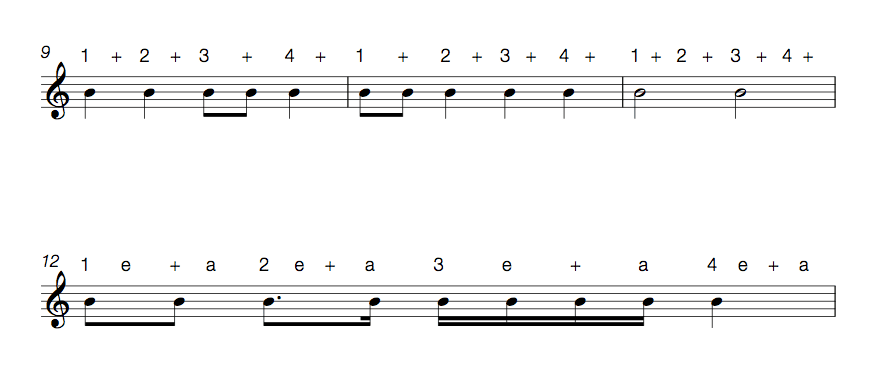Sight Reading with Rhythmic Subdivision
In this article we’ll look at sight reading with rhythmic subdivision. This is an advanced counting technique that can help you develop solid rhythm.
As you advance on classical guitar, you will encounter more complex rhythms with smaller durations and syncopation. Rhythm is king when it comes to sight reading. So it is important to develop tactics to handle difficult rhythms. This technique will help you tackle even the trickiest of rhythms.
Subdivision
It is called “subdivision” and it is the best way I know of breaking down rhythms into bite-sized chunks.
To start off, I want you to think of rhythm as duration, not as speed. It is an easy misconception to see lots of stems and tails and think of them as “fast.” 16th notes and 32nd notes (semiquavers and demi semiquavers) look intimidating. But they don’t have to be.
It is all relative.
If you have 16th notes and the pulse is marked at 30 MM then you are going to have plenty of time to play each of those notes. Likewise if the tempo is marked 250MM and you just have quarter notes marked then you will have to play those notes very quickly! So, start to think of rhythms as durations rather than speed and know that when slowed down enough, any rhythm is possible.
Subdivision takes the smallest duration in the passage (let’s say the smallest duration is a sixteenth note) and creates a click track set at that duration. Normally, we will set a metronome at the quarter note, but by setting the metronome clicks at smaller durations it makes it easier to slot in each note where it belongs.
The metronome?
When I say, “metronome clicks” it doesn’t actually have to be the metronome, you can count in your head or out loud, but you do have to be thinking of the smaller durations as your markers.
When you subdivide your rhythms, you are creating a grid on which to map your notes. It means that your notes will be much steadier. It also takes the guesswork out of your counting. Eighth notes are often counted as 1 & 2 & 3 & 4 &. Or simply 1 + 2 + 3 + 4 +. You can sound out sixteenth notes as: 1 e & a 2 e & a 3 e & a 4 & a. There are other ways of sounding them out, but whatever works for you is best.
Subdivision in Ensemble Settings
Subdivision is very useful for ensemble playing. If you have a very long note and three people are all counting quarter notes beats in their head, there will probably be some very out of time notes. But, if everyone is subdividing, it leaves less room for error. Take a look at the third measure above as an example.
Try it out and let us know your thoughts in the comments below.
If you want to work on your sight reading right now, we have courses on notation and sight reading at every level at CGC Academy. Become a member of CGC Academy today!


I’m looking for your input concerning the proper approach for a late senior- 77 years old- approaching the classical guitar. I have been playing for about 5 years with lessons given off and on. All of the lessons were of the approach of here is some music, let’s learn how to play it. After finding your site and subscribing to it, I realize that there are many steps that I have not learned. I’m looking for your suggestions that might get me onto a steady road to becoming a more disciplined and accomplished guitar player.
Thank you in advance for you guidence.
Regards,
Jerry Gerig
Hi Jerry,
Well that is a big answer, but in short, the best thing you could do is find a good local teacher to work with and progress slowly with goals. If you want to use this site, really delve into the materials along with the written lessons and take plenty of time to progress throughout the levels. It is important to record yourself for objectivity and celebrate successes.
Cheers,
Simon
I could not agree more with this man’s post. I am 49, an Ex Nuclear Submariner (I need to understand the What as much as the How.. Most teaching focuses on the How)
Jack
Phila Pa
I have come to the classical guitar late – age 59 – but had ‘played’ around with guitars since a teenager – playing endless blues riffs and such. I am teaching myself now, but this site is the first one I have come across that is actually REALLY good. There are plenty of good guitar players, but not many good guitarists who are also good communicators, either in video and/or in their ability to write well.
Such a nice comment, Tony. Thank you.
Hello Simon,
I was happy to hear that Jerry Gerig at 77 is learning to play the Classical Guitar
this encouraged me very much.
I am going onto 79 and started to study the classical guitar using S. Ranieri method for the guitar.
I have almost completed book 1 and going onto Book11.
I was delighted to find your site and will be joining you soon ( On return from my holidays ).
Music is not only one of the best ways of relaxing, it is also a good way to make friends in foreign lands even if you do not speak the language.
I am glad I am not the only old dog learning new tricks !!
Regards………….Donald
Great Webinar you were hours ahead of the Superbowl. A good philosophy I’ve found. Learn a song, Play that song. Perform the song and spend the rest of you days making love to it.